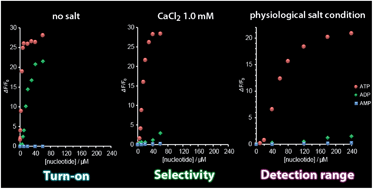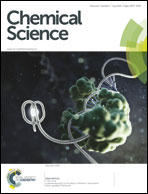Tailoring of the desired selectivity and the turn-on detection range in a self-assembly-based fluorescence sensory system†
Abstract
This study demonstrates how to control the selectivity and the turn-on detection range toward the tailoring of an assembly-based fluorescence (FL) sensory system. Assembly-based FL chemosensors composed of oligophenylenevinylene with a varied number of guanidinium receptors (G2, G4 and G6) were newly developed, and their FL response to nucleotides (AMP, ADP and ATP) was investigated. Indeed, G6 exhibited FL emission via self-assembly with ATP. More importantly, the FL response of G6 showed markedly improved selectivity for ATP over ADP and a broadly extended detection range of ATP concentration under adjusted salt conditions. The salt effect on the FL response revealed the competitive binding interactions affecting the subsequent self-assembly process. These studies have unveiled the pivotal binding mechanisms operating in the self-assembly process, which tailor the performance level of the assembly-based sensory system. We believe that this study offers a new design principle of an assembly-based FL chemosensor with high selectivity and the appropriate detection range, being different from the conventional key-and-lock system.


 Please wait while we load your content...
Please wait while we load your content...